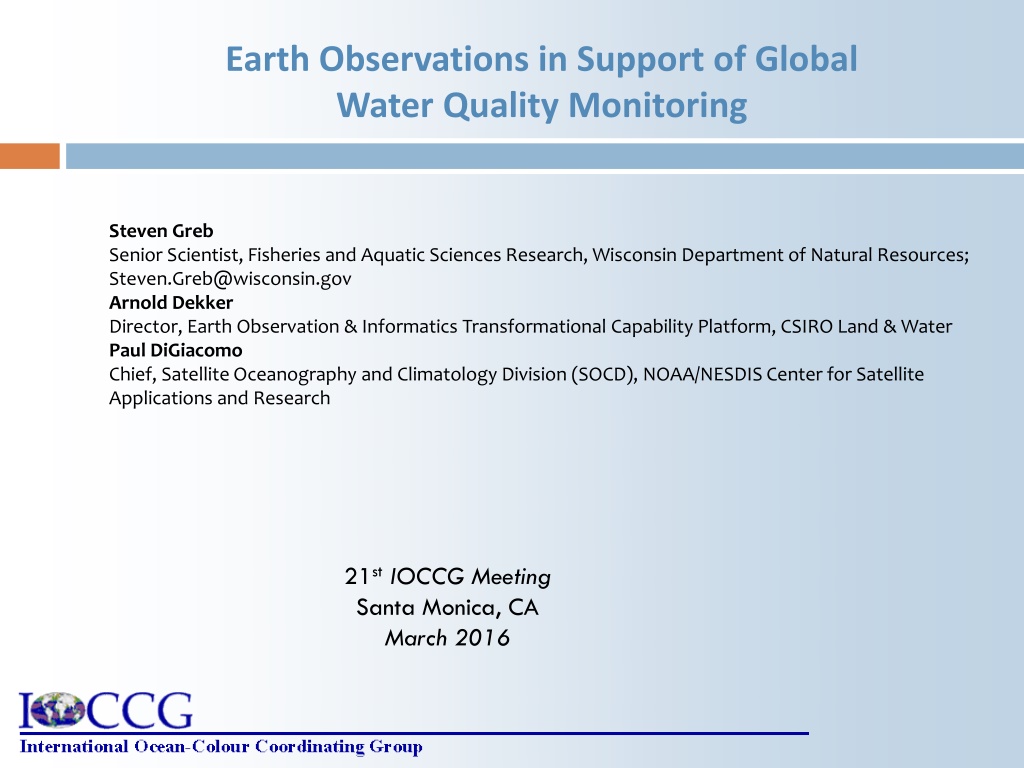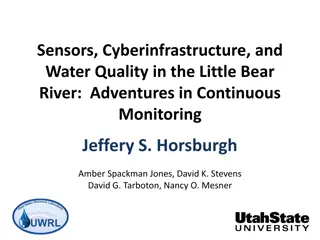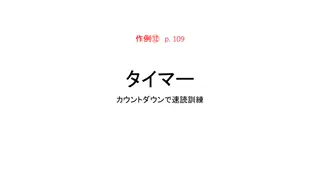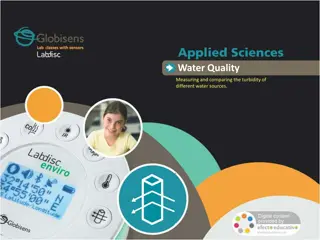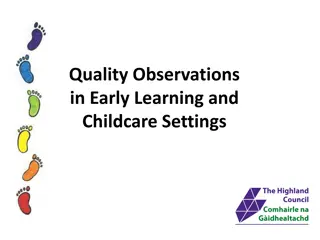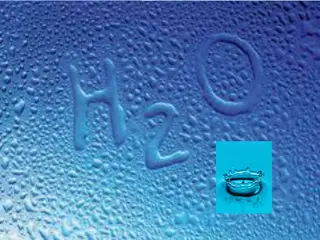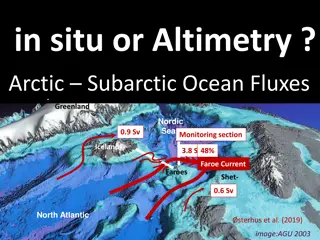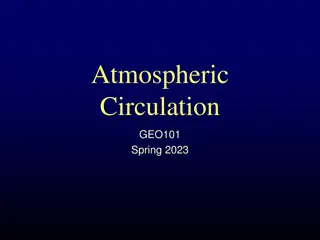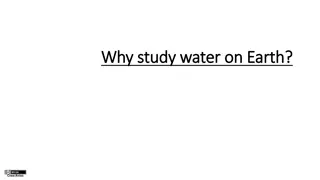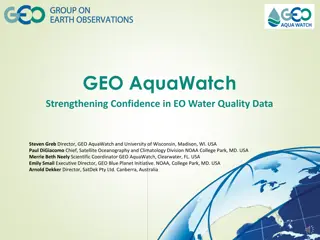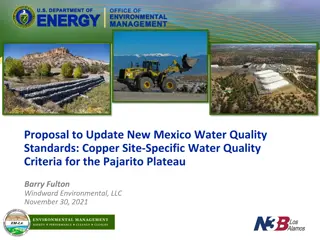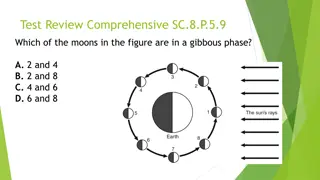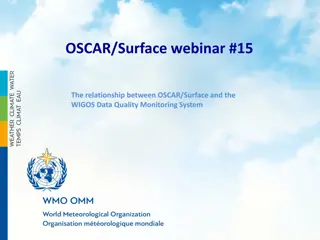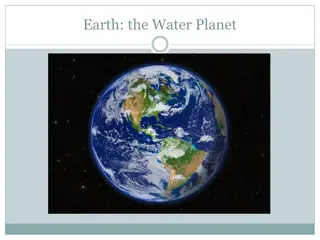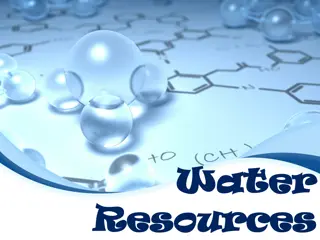Earth Observations for Global Water Quality Monitoring
Declining water quality is a pressing global issue, impacting ecosystems and human health. This project aims to assess current knowledge, identify new observing capabilities, and engage users to enhance water quality monitoring through Earth observations. Key milestones include completing draft proposals, organizing meetings, and outlining report structures to drive effective research and development activities.
Download Presentation

Please find below an Image/Link to download the presentation.
The content on the website is provided AS IS for your information and personal use only. It may not be sold, licensed, or shared on other websites without obtaining consent from the author. Download presentation by click this link. If you encounter any issues during the download, it is possible that the publisher has removed the file from their server.
E N D
Presentation Transcript
Earth Observations in Support of Global Water Quality Monitoring Steven Greb Senior Scientist, Fisheries and Aquatic Sciences Research, Wisconsin Department of Natural Resources; Steven.Greb@wisconsin.gov Arnold Dekker Director, Earth Observation & Informatics Transformational Capability Platform, CSIRO Land & Water Paul DiGiacomo Chief, Satellite Oceanography and Climatology Division (SOCD), NOAA/NESDIS Center for Satellite Applications and Research 21stIOCCG Meeting Santa Monica, CA March 2016
Earth Observations in Support of Global Water Quality Monitoring Rationale Declining water quality has become a global issue Nutrient over enrichment of freshwater and coastal ecosystems Water-borne diseases Lack of systematic water quality monitoring programs. http://dnr.wi.gov/wnrmag/2013/02/images/loon3.jpg WDNR photo EPA photo
Earth Observations in Support of Global Water Quality Monitoring Overarching Objectives: Assess current knowledge regarding coastal and inland water quality and associated use of remote sensing data Assess existing and identify new space-based and in situ observing capabilities Identify supporting research and development activities Identify best practices and new & improved data streams and products User engagement and outreach
Water Quality Monitoring Report Timeline Draft proposal completed Jan 2014 19th IOCCG Meeting First Organizational Meeting Meetings World Lakes Conference Milestones Chapter Outlines Approved Structure Approved Working Group Accepted 2014 Timeline May Jan Feb Mar Apr Jun Jul Aug Sep Oct Dec Nov Report Structure Chapter Outlines Activities Report Writing
Water Quality Monitoring Report Timeline Draft proposal completed Jan 2014 19th IOCCG Meeting First Organizational Meeting Meetings World Lakes Conference Milestones Chapter Outlines Approved Structure Approved Working Group Accepted 2014 Timeline May Jan Feb Mar Apr Jun Jul Aug Sep Oct Dec Nov Report Structure Chapter Outlines Activities Report Writing GEO Water Quality Summit 20th IOCCG IOCS Telecon Telecon Meetings Milestones 2015 Timeline May Jan Feb Mar Apr Jun Jul Aug Sep Oct Dec Nov Report Writing Activities
Water Quality Monitoring Report Timeline Future Plans 21th IOCCG Meeting GloboLakes Meeting Meetings IOCCG mid-term Exec. Comm./OO Milestones Submission of final draft report to IOCCG Chapters Completed 2016 Timeline May Jan Feb Mar Apr Jun Jul Aug Sep Oct Dec Nov Report Writing Activities Report Compiled and Edited Report compiling, review, feedback to authors, additional revisions Copy and technical review
Earth Observations in Support of Global Water Quality Monitoring Working Group Membership First name Stewart Caren Carsten Arnold Paul Mark Steven Steve Milton Chris Yuji Blake Richard Andrew Menghua Last name Bernard Binding Brockman Dekker DiGiacomo Dowell Greb Groom Kampel Mannaerts Sakuno Schaeffer Stumpf Tyler Wang Affiliation CSIR Environment Canada CB Assoc. CSIRO NOAA JRC WDNR PML INPE ITC Hiroshima Univ. USEPA NOAA Univ. Stirling NOAA Country South Africa Canada Germany Australia USA Italy USA UK Brazil Netherlands Japan USA USA UK USA 1 2 3 4 5 6 7 8 9 10 11 12 13 14 15
Earth Observations in Support of Global Water Quality Monitoring Working Group Membership Additions First name Stewart Caren Carsten Arnold Paul Mark Steven Steve Milton Chris Yuji Blake Richard Andrew Menghua Daniel Erin Evangelos Mark Veronica Emily Tiit Last name Bernard Binding Brockman Dekker DiGiacomo Dowell Greb Groom Kampel Mannaerts Sakuno Schaeffer Stumpf Tyler Wang Odermatt Hestir Spyrakos Matthews Lance Smail Kutser Affiliation CSIR Environment Canada CB Assoc. CSIRO NOAA JRC WDNR PML INPE ITC Hiroshima Univ. USEPA NOAA Univ. Stirling NOAA Brockmann Assoc. NC State Univ. Stirling Cyanolakes NOAA NOAA/GEO U. Estonia Country South Africa Canada Germany Australia USA Italy USA UK Brazil Netherlands Japan USA USA UK USA CH USA UK South Africa USA USA Estonia 1 2 3 4 5 6 7 8 9 10 11 12 13 14 15 16 17 18 19 20 21 22
Earth Observations in Support of Global Water Quality Monitoring Report framework centered on three audiences with three differing time scales
Earth Observations in Support of Global Water Quality Monitoring Report framework centered on three audiences with three differing time scales Report Partition Time horizon Audience Societal Infrastructure End Users Section A Short time frame 0-1 yr Science Infrastructure Research Community Section B Mid range 1-5 yr Section C Technical Infrastructure Space Agencies Long range
Earth Observations in Support of Global Water Quality Monitoring Section A: User/manager short time frame, Societal Infrastructure Chapter 1: Stakeholder frameworks, needs, and requirements Co-leads: Blake*, Steve Greb, Caren Chapter 2: Introduction to deriving water quality measures from satellites Co-lead: Caren*, Rick, Blake , Andrew Chapter 3: Complementarity of in-situ and satellite measurements Co-leads: Steve Greb*, Blake, Paul, Menghua, Evangelos, Mark, Daniel Chapter 4: Linkages between data providers and end users Co-lead: Rick*, Carsten, Paul, Rick, Blake, Arnold
Chapter 1 Water Quality Monitoring and Assessment: Needs, Benefits and Frameworks The need for protecting water s designated uses Benefits of maintaining water designated uses Environmental Stewardship Human Health Economy Gambia News Community Frameworks for monitoring and protecting designated uses Global and regional challenges How satellite remote sensing can contribute Wisconsin DNR photo
Chapter 2 Introduction to Deriving Water Quality Measures from Satellites Theoretical Basis of Water Quality Remote Sensing What Can be Measured Using Remote Sensing? Water Quality Retrieval Algorithms Platform, Resolution, and Data Processing Considerations Advantages and Limitations of Remote Sensing for Water Quality Monitoring
Chapter 3 Complementarity of In-situ and Satellite Measurements Water quality monitoring approaches Discussion of measurement statistics and related attributes for all three approaches Accuracy Representativeness considerations Complementary role of remote sensing with in situ measurements Complementary role of remote sensing with modelling Costs Resources
Chapter 4 Linkages Between Data Providers and End Users Data delivery Data formats Data extraction and analysis tools Training Quality Control Validation Timeliness Real-time Monitoring and Response Current Assessment Retrospective Assessment Future Collaborative Efforts
Earth Observations in Support of Global Water Quality Monitoring Section B: Remote Sensing Science 1-5 yr. time frame, Science Infrastructure Chapter 5: Measures from satellites Co-leads: Stewart*, Mark, Menghua, Carsten, Andrew, Yuji, Tiit Chapter 6: Sensors Co-leads: Arnold*, Erin, Milton, Menghua, Stewart
Chapter 5 Measures from Satellites Understanding the satellite signal measured from inland and coastal waters The water-leaving signal The atmospheric signal Deriving water quality products from satellite: algorithms and issues Algorithm types Outlook Credit: Lisl Robertson Lain
Chapter 6 Sensors The directly measurable variables of interest Spectral band requirements Spatial, radiometric, and temporal resolution requirements Trade-offs and solutions between spectral, spatial, radiometric and temporal requirements The application potential of relevant existing and planned space-borne sensors Credit: Spyrakos
Earth Observations in Support of Global Water Quality Monitoring Section C: Agencies long time frame Technical infrastructure Chapter 7 Space Segment & CalVal Support Infrastructure Co-Leads: Milton, Paul*, Menghua, Mark, Chris, Arnold Chapter 8 Ground Segment Co-Leads: Arnold, Steve Groom*, Chris, Carsten Chapter 9 New Concepts (Virtual Laboratory) Co-Leads: Carsten*, Steve Groom, Paul Chapter 10 Data Exploitation, Programmes and User Support Co-Leads: Carsten*, Paul, Rick, Blake Chapter 11: Recommendations and outlook Co-leads Steve Greb, Paul, Arnold
Chapter 7 Coastal and Inland Water Quality Observing System Assets and Supporting Infrastructure Observing System Assets: Current Status and Future Directions Satellite Assets In situ Assets Supporting observing system infrastructure Calibration and Validation Recommendations to agencies and programs
Chapter 8 Ground and User Segment Mission or satellite ground segment Data distribution mechanisms Web-based analysis systems User Ground Segments ChloroGIN-Lakes: an end-to-end demonstrator
Chapter 9 New Concepts (Virtual Laboratory) Big data from Space Historic archives and future data volumes Challenges for data access and data processing Moving software to the data Data harmonization ( Data Cube ) Exploratory tools (e.g. Product Feature Extraction) Community tools and Mobile Technology Citclops EC-FP7 Programme Australian Geoscience Data Cube
Chapter 10 Data Exploitation Programs and User Support User support programs Thematic workshops Dedicated R&D studies Validation http://www.start.org/images/2015/GEOSS_Science_Tech_workshop.png GEOSS in the Americas UFI Photo
Questions? http://images.huffingtonpost.com/2013-02-18-SantaMonica_CA_Image.jpg Huffington Post
GEO Water Quality Community of Practice Work Package 1: Initiation of GEO Water Quality CoP 0-1 year Executive Committee Work Package 2: Ongoing and developing water quality project inventory 0-2 years Increasing Resources required Work Package 3: Development of baseline global water quality products Secretariat 1-3 years Steering and Advisory Committee Implementation Board Work Package 4: Local/regional end-to-end prototype project demonstration 1-3 years Work Package 5: 3-5 years Develop initial demonstration global water quality monitoring service Working Group 1 Working Group 2 Working Group 4 Working Group 5 Working Group 3 Work Package 6: 5 - 10 years Transition to routine and sustained global water quality monitoring service Work Package 7: 5 - 10 years Expand water quality monitoring service to include forecasting service
